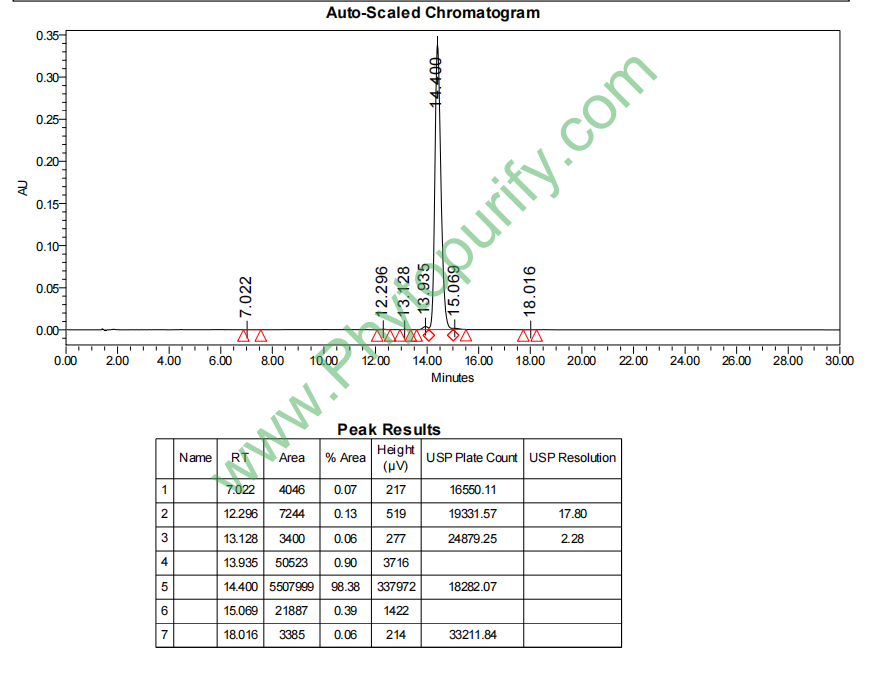
10-ShogaolCAS No.:36752-54-2
|
||||||||||
 |
|
|
||||||||

| Catalogue No.: | BP1771 |
| Formula: | C21H32O3 |
| Mol Weight: | 332.484 |
Product name: 10-Shogaol
Synonym name:
Catalogue No.: BP1771
Cas No.: 36752-54-2
Formula: C21H32O3
Mol Weight: 332.484
Botanical Source: Ginger
Physical Description: Oil
Type of Compound: Phenols
Purity: 95%~99%
Analysis Method: HPLC-DAD or/and HPLC-ELSD
Identification Method: Mass, NMR
Packing: Brown vial or HDPE plastic bottle
The product could be supplied from milligrams to grams. Inquire for bulk scale.
We provide solution to improve the water-solubility of compounds, thereby facilitating the variety of activity tests and clinic uses.
For Reference Standard and R&D, Not for Human Use Directly.
Description:
10-Shogaol, as an antioxidant for human skin cell growth and a migration enhancer with potential to be a novel wound repair agent.8- and 10-Shogaol have similar metabolic profiles to [6]-shogaol and exhibit similar toxicity toward human colon cancer cells.
References:
Int J Mol Sci. 2012;13(2):1762-77.
10-Shogaol, an antioxidant from Zingiber officinale for skin cell proliferation and migration enhancer.
METHODS AND RESULTS:
In this work, one of Zingiber officinale components, 10-Shogaol, was tested with 1,1-diphenyl-2-picrylhydrazyl (DPPH) radical scavenging, metal chelating ability, and reducing power to show antioxidant activity. 10-Shogaol promoted human normal epidermal keratinocytes and dermal fibroblasts cell growths. 10-Shogaol enhanced growth factor production in transforming growth factor-β (TGF-β), platelet derived growth factor-αβ (PDGF-αβ) and vascular endothelial growth factors (VEGF) of both cells. In the in vitro wound healing assay for 12 or 24 h, with 10-Shogaol, the fibroblasts and keratinocytes migrated more rapidly than the vehicle control group.
CONCLUSIONS:
Thus, this study substantiates the target compound, 10-Shogaol, as an antioxidant for human skin cell growth and a migration enhancer with potential to be a novel wound repair agent.
J Agric Food Chem. 2014 May 21;62(20):4632-42.
Cysteine-conjugated metabolites of ginger components, shogaols, induce apoptosis through oxidative stress-mediated p53 pathway in human colon cancer cells.
Shogaols, the major constituents of thermally processed ginger, have been proven to be highly effective anticancer agents.
METHODS AND RESULTS:
Our group has identified cysteine-conjugated shogaols (M2, M2', and M2″) as the major metabolites of [6]-, [8]-, and 10-Shogaol in human and found that M2 is a carrier of its parent molecule [6]-shogaol in cancer cells and in mice, while being less toxic to normal colon fibroblast cells. The objectives of this study are to determine whether M2' and M2″ behave in a similar manner to M2, in both metabolism and efficacy as anticancer agents, and to further explore the biological pro-apoptotic mechanisms of the cysteine-conjugated shogaols against human colon cancer cells HCT-116 and HT-29.
CONCLUSIONS:
Our results show that [8]- and 10-Shogaol have similar metabolic profiles to [6]-shogaol and exhibit similar toxicity toward human colon cancer cells. A brief screen of the markers attenuated by the proapoptotic activity of M2 revealed similar results for [8]- and 10-Shogaol and their respective cysteine-conjugated metabolites M2' and M2″. This study highlights the cysteine-conjugated metabolites of shogaols as novel dietary colon cancer preventive agents.
HPLC of 10-Shogaol
